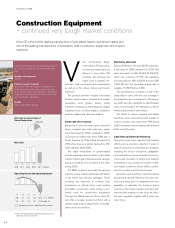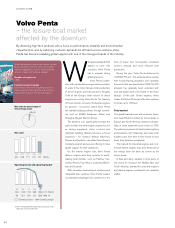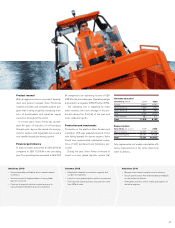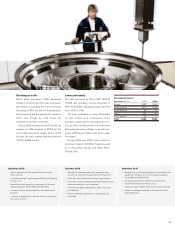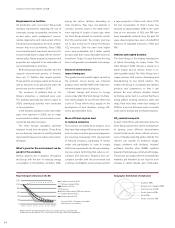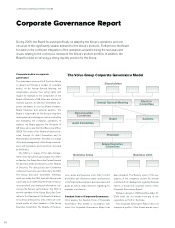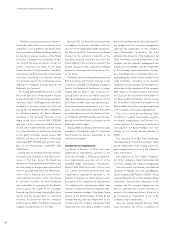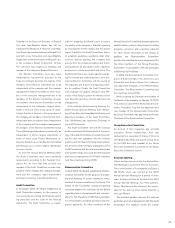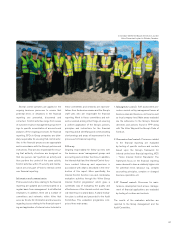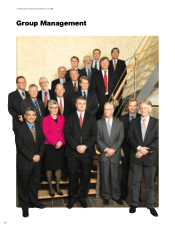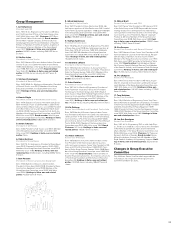Volvo 2009 Annual Report Download - page 57
Download and view the complete annual report
Please find page 57 of the 2009 Volvo annual report below. You can navigate through the pages in the report by either clicking on the pages listed below, or by using the keyword search tool below to find specific information within the annual report.
Emissions regulations for trucks and buses
EPA 2010
EPA 2007
0,16
0,14
0,12
0,10
0,08
0,06
0,04
0,02
0,00
Particles, g/kWh
NO
x, g/kWh
012345678
Euro II, 1996
Euro III, 2002
Euro IV, 2006
Euro V, 2009
EPA 2002
In September 2009, Euro V was implemented in
Europe and in January 2010, EPA 2010 was
implemented in North America. Euro V entails a
50% reduction of NOx emissions compared to Euro
IV. With the implementation of EPA 2010, emission
levels for particulates and NOx are very close to zero.
Euro VI, 2013
partner to customers, suppliers, other busi-
ness partners and entities in society as well as
a good employer.
The Volvo Group strives to take responsibil-
ity through such actions as imposing demands
on its suppliers. Since 2006, social issues
have been an integral part of supplier evalu-
ations and in 2008 a Group-wide project was
implemented for the purpose of further focus-
ing on this area.
Sustainability organization
Responsibility for the Volvo Group’s efforts
surrounding corporate social responsibility
issues is coordinated at the head ofce in line
with the respective operational responsibil-
ities. Work on core values is coordinated by a
Group Council.
Dialog with stakeholders
The Volvo Group strives to maintain straight-
forward, open communications with the world
at large and participates in the active exchange
of information with stakeholders on many dif-
ferent levels and in many different contexts.
The Group strives to consider different view-
points and evaluate these against our own
internal strategies for the purpose of achieving
sustainable development.
With the aim of being an active player in
social development and to nd business oppor-
tunities, it is essential that the Group is informed
about the surrounding world. It is with that in
mind that the Volvo Group analyzes social
trends and follows the development of new leg-
islation in regions in which the Group is active.
AB Volvo published its rst environmental
report in 1990. From 2002–2006 the Sustain-
ability Report was part of the Annual Report.
Since 2007, a separate Sustainability Report,
inspired by GRI (Global Reporting Initiative),
has been published. Detailed environmental
data is reported annually in a separate report.
Environmental
responsibility
High demands on production
and products
Environmental management is a cornerstone
of the Group’s efforts to promote long-term
sustainability. Volvo’s environmental work has
three distinct goals: to reduce the environmen-
tal impact of production, to reduce the impact
from the use of its products and to reduce the
impact from the Group’s own transports.
Guidance and control in the
environmental area
One of the most important elements for guid-
ance of environmental issues at the Volvo
Group is the common environmental policy.
The policy forms the basis for the Group’s
envir onmental management systems, strate-
gies, goals, audits and actions.
The environmental policy states that envir-
onmental efforts shall be marked by a holistic
view, continuous improvements, technical inno-
vation and efcient use of resources. The pol-
icy is, in turn, divided into strategies and goals
for the organization.
The rst environmental management sys-
tem was certied already in 1995. At the end
of 2009, 96% of the employees worked in
production units in accordance with certied
environmental management systems, primarily
ISO 14001:2004. Other aspects of the value
chain – such as product development and
marketing – also have management systems.
Most employees work in operations that have
quality management systems certied in
accordance with ISO 9001:2000.
The Group’s environmental goals are used
to monitor the entire organization, they are
geared towards both the Group’s own busi-
ness and the use of the products. The goals
are closely linked to business plans.
During the years 2004–2008, the Volvo
Group focused on energy reduction in the manu-
facturing operations. This resulted in a 43%
decrease of energy use per produced unit.
The goal for the next three years is a reduc-•
tion of a further 15%. Furthermore, a spe-
cic follow-up of idling losses will be carried
out; i.e. the energy usage during down time
in production.
The rst steps have been taken toward •
making the Group’s production plants CO2
neutral. Currently, the possibilities to make
more plants CO2 neutral are investigated.
A Group goal for more efcient use of pur-•
chased raw materials have been set. The
goal calls for an increased material ef-
ciency and an intensied follow-up of the
waste streams that come from prioritized
raw materials.
Product use goals include:
Achieving high fuel efciency and low emis-•
sions throughout the entire life cycle
Making comparisons with the best •
Consistent implementation of activities to •
become the industry leader
Generating environmental data for follow-•
up and communication during the develop-
ment of every new product
Implementing a strategy for future fuels •
Including alternative fuels and alternative •
drivetrains in the product portfolio.
The environmental program also includes part-
ners. Environmental requirements have been
used since 1996 as an integral component of
supplier evaluations and follow-up of various
purchasing organizations.
53



